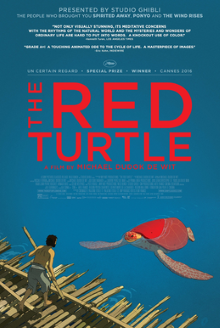
This film ticks all the right boxes for being added to my list: it premiered at the Cannes Film Festival, it was nominated for the Academy Awards, and most intriguingly, it is a cooperative effort by a German company and Studio Ghibli. It was directed by Michaël Dudok de Wit, a Dutch animator, and its artistic sensibilities are distinctly European but I like to think that the Japanese provided their characteristic technical precision.
A man is shipwrecked in a storm and washes ashore on a small, uninhabited island. Exploring the island, he finds fresh water there and is able to subsist on fruits. A copse of bamboo provides plenty of building materials so he builds a rudimentary raft. As he paddles out into the sea however the raft is destroyed by an unseen underwater creature and he is forced to return to the island. He persists with the same result and on his third attempt he finally sees that a giant red turtle has been bashing his raft but leaves him unharmed. As he builds his fourth raft he notices the turtle waddling ashore. In a fit of rage, he attacks the turtle with a branch and overturns it so that it is unable to move. As he sees the turtle dying he feels remorse but it is too heavy for him to flip it back. He tries giving fish and water to the turtle but it doesn’t seem to help. One day the turtle’s shell cracks and he is shocked to see that inside the shell is an adult woman.
Between its art and the complete lack of dialogue, so that the storytelling is purely visual, The Red Turtle doesn’t lack for charm. However I was initially dismayed when what looked like a survivalist story took a fantastical turn. Even after I’d accepted the fact that the film really is all about a man’s relationship with a red turtle that magically transforms into a beautiful woman, I couldn’t quite grasp the point it was trying to make. But then it struck me that this is really an interesting variation of the age-old selkie story such as what we’ve seen in Song of the Sea and suddenly I could appreciate it much more. Even little details like how the man hits the turtle with a branch has parallels with fishermen clubbing seals to knock them unconscious and dragging them home whereupon they transform into human women.Naturally as in all selkie stories, the man and the woman has a child together and the child has characteristics of both species.
By presenting such a different version of this old legend, The Red Turtle forces the viewer to reexamine the elements that make selkie stories such a powerful and enduring tale with a fresh pair of eyes. While the focus of The Song of the Sea was on the child who is the product of their union, I liked how this film emphasizes that the legend is inherently a romantic tragedy. It even switches things around by having the turtle be the one who initially maroons the man on the island. He of course falls in love with her and voluntarily stays on the island but he does give up the rest of the world in doing so and dies on the island. Even their child growing up and eventually leaving the nest carries a sense of loss. This is why although it is quite simple, I do not consider this to be an animated feature that is aimed at children.
All in all, I found to be a beautiful, poignant film and a great example of what a European-Japanese collaborative process can achieve.